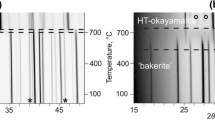Abstract
The dehydration of two specimens of perlite from Pálháza (Hungary) and from Borovitza (Bulgaria) along with a specimen of Australian precious opal has been investigated by temperature controlled high-vacuum degassing experiments (DEGAS). Dehydration results in the loss of water over a wide range of temperatures due to the presence of both molecular and bound (silanol, Si–OH) water. A surprising observation is that hydrogen (H2) is also released. The hydrogen is observed to be released from both perlites and opal and both by diffusional processes and through the sudden explosive, bursting of inclusions which produce sharp spikes in the MS data. The origin of the hydrogen cannot be explained by a simple statistical distribution of the silanol species in the vitreous matrix; rather, it is more likely to be associated with an inverse-micellar decomposition of silanol species. Alternate sources of hydrogen such as meteoric waters or specific genetic origins based on the perlite or opal location and formation are discounted as the hydrogen release is found to be independent of CO2 and SO2 evolution.














Similar content being viewed by others
References
Roulia M, Chassapis K, Kapoutsis JA, Kamitsos EI, Savvidis T. Influence of thermal treatment on the water release and the glassy structure of perlite. J Mat Sci. 2006;41:5870–81.
Ivanova VP, Kasatov BK, Krasavina TN, Rozinova EL. Termičeskij analiz mineralov I gornyh porod. Leningrad: Nedra; 1974. p. 399.
Földvari M. Handbook of thermogravimetric system of minerals and its use in geological practice. Budapest: Geological Institute of Hungary; 2011. p. 36–136.
Lehman H, Rossler M. A Contribution to the nature of water binding in perlite, in thermal analysis. Proceedings of 4th ICTA, Budapest; 1974. vol. 2, p. 619–628.
Kužvart M. Industrial minerals and rocks. Praha: Academia; 1984. p. 320–1.
Thomas PS, Guerbois JP, Smallwood A. Low temperature DSC characterisation of water in opal. J Therm Anal Calorim. 2013;113:1255–60.
Bagdassarov N, Ritter F, Yanev Y. Kinetics of perlite glasses degassing: TG and DSC analysis. Glass Sci Technol. 1999;72:277–90.
Heide K, Földvari M. High temperature mass spectrometric gas-release studies of kaolinite Al2[Si2O5(OH)4] decomposition. Thermochim Acta. 2006;446:106–12.
Heide K, Földvári M, Zelenka T, Heide G. Gas release from Hungarian perlites. In: 6th international conference and exhibition on perlite, Budapest. 2008. pp. 95–106.
Földvari M. Measurement of different water species in minerals by means of thermal derivatography. In: Smykatz-Kloss W, Warne SSJ. Thermal analysis in the geosciences. Lecture Notes in Earth Sciences Nr. 38, Springer Verlag. 1991. pp. 84–100.
Thomas P, Šesták J, Heide K, Füglein E, Šimon P. Thermophysical properties of natural glasses at the extremes of the thermal history profile. In: Šesták J, Mareš JJ, Hubik P, editors. Hot topics in thermal analysis and calorimetry, vol. 8. Dordrecht: Springer; 2011. p. 311–25.
Heide K, Woermann E, Ulmer G. Volatiles in pillows of the Mid-Ocean-Ridge-Basalt (MORB) and vitreous basaltic rims. Chem Erde. 2008;68:353–68.
Heide K. Zur thermischen Zersetzung des Gipses CaS04 · 2H20. Silikattechnik. 1969;20:232–43.
Zotov N, Dimitrov V, Yanev Y. X-ray radial distribution function analysis of acid volcanic glasses from the Eastern Rhodopes, Bulgaria. Phys Chem Miner. 1989;16:774–82.
Yanev Y. Petrology of Eastern Rhodopes paleogene acid volcanics, Bulgaria. Acta Vulcanologia. 1998;10:265–77.
Yanev Y. Cesium-bearing perlites from Borovitza Caldera in the Eastern Rhodopes, Bulgaria. Petrology. 1994;2:82–97.
Zelenka TA. pálházai és környéki perlitek földtana.(Geology of the perlites in the Pálháza Region). In: 6th international conference and exhibition on perlite, Budapest. 2008. pp. 51–76.
Langer K, Florke OW. Near infrared absorption spectra (4,000–9,000 cm−1) of opals and the role of water in these SiO2.nH2O minerals. Fortschr Miner. 1974;52:17–51.
Brown LD, Ray AS, Thomas PS. 29Si and 27Al NMR study of amorphous and paracrystalline opals from Australia. J Non-Cryst Sol. 2003;332:242–8.
Brown LD, Ray AS, Thomas PS. Elemental analysis of Australian amorphous opals by laser-ablation ICP-MS. Neues Jahrbuch für Mineralogie-Monatshefte. 2004;2004:411–24.
Author information
Authors and Affiliations
Corresponding author
Rights and permissions
About this article
Cite this article
Thomas, P.S., Heide, K. & Földvari, M. Water and hydrogen release from perlites and opal. J Therm Anal Calorim 120, 95–101 (2015). https://doi.org/10.1007/s10973-014-4336-8
Received:
Accepted:
Published:
Issue Date:
DOI: https://doi.org/10.1007/s10973-014-4336-8




